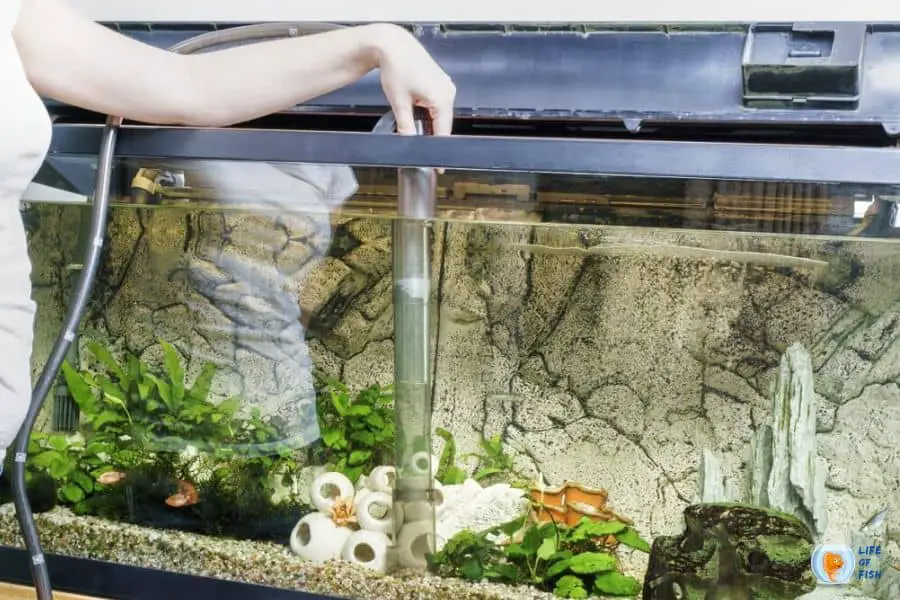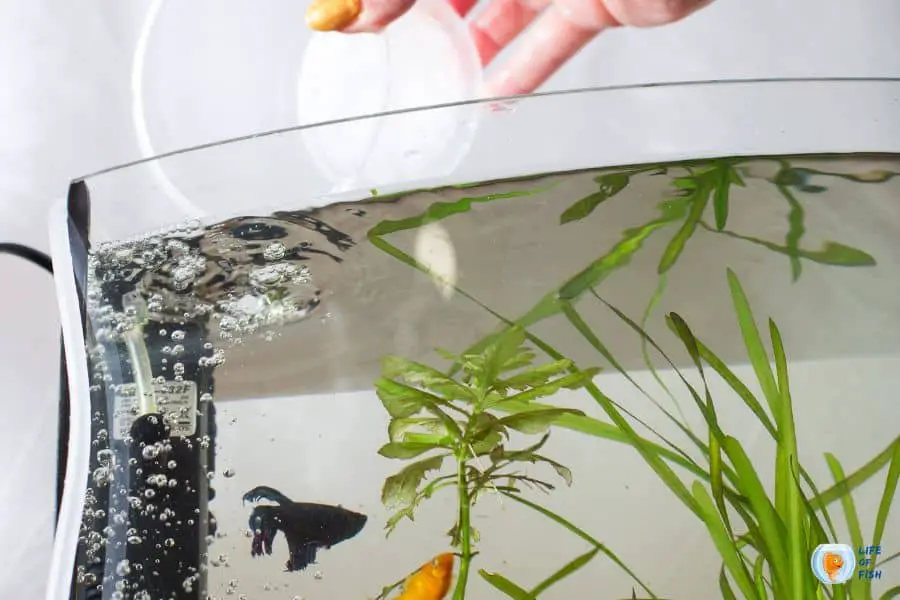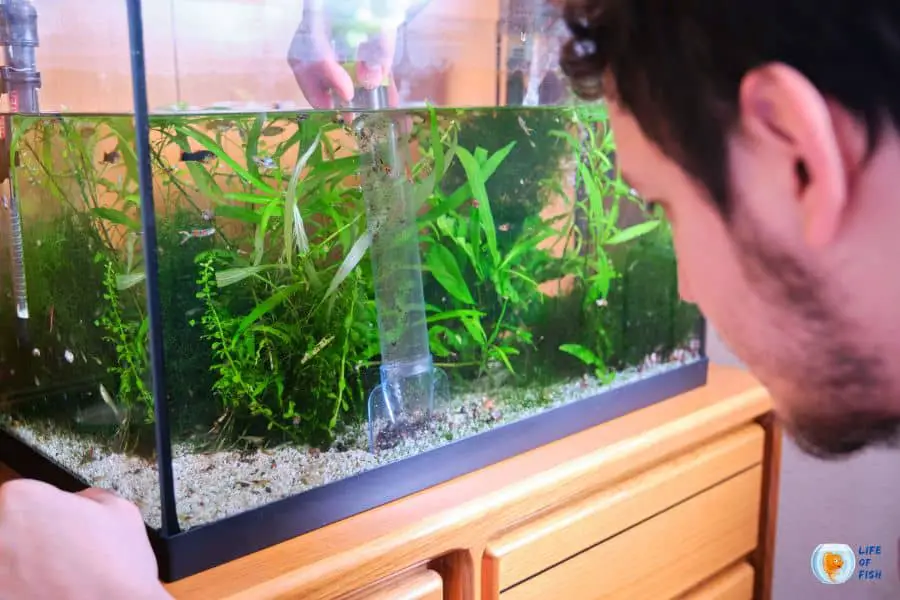What about performing regular, routine water changes? Are daily water changes bad for fish? While there are arguments for and against performing daily water changes, the truth is that there is no definitive answer. It really depends on the fish species, the fish’s environment, and the fish keeper’s goals.

Many fish owners know the importance of changing the water to maintain a healthy aquarium. They also know that water changes are sometimes necessary in order to correct problems that have arisen, such as high nitrate levels.
There are some benefits to performing daily water changes. For example, it can help keep the water quality high and prevent problems before they start. Additionally, it can be a good way to bond with your fish. But there can also be some drawbacks to daily water changes. This article will go over the benefits and drawbacks of daily water changes so you can make informed choices about whether they are right for your fish.
The Purpose Of Water Changes
Jump To
- 1 The Purpose Of Water Changes
- 2 Types Of Water Changes
- 3 How Often Should Fish Water Be Changed?
- 4 Are Daily Water Changes Bad For Fish?
- 5 Is A 50 Water Change Too Much?
- 6 Can You Do A 100 Percent Water Change In My Fish Tank?
- 7 How to Do 100% Water Change in Your Aquarium?
- 8 Is 30% Water Change Too Much?
- 9 Can I Change My Aquarium Water Every 3 Days?
- 10 Why Are My Fish Swimming Upside Down After Water Change?
- 11 What Are The Ideal Water Parameters for My Fish?
- 12 Fish Died After Water Change
- 13 How Do You Save A Dying Fish After Water Change?
- 14 Conclusion
An aquarium is an enclosed system, and the water quality can degrade over time. The build-up of waste products, such as ammonia and nitrates, can be harmful to fish. Additionally, algae and other debris accumulation can make the water murky and unattractive.
Water changes help address these issues by removing and replacing some of the water with fresh, clean water. This dilutes the concentration of waste products and debris, making the water safer for fish. Water changes can also help remove any build-up of algae and other debris from the aquarium.
Types Of Water Changes
There are two main types of water changes: partial and complete. A partial water change involves removing some of the water from the aquarium and replacing it with fresh water. The amount of water that is removed and replaced will vary, but it is typically around 25%.
A complete water change involves removing all of the water from the aquarium and replacing it with fresh water. This is usually only done when the water quality is really bad, or there is a major problem, such as excessive ammonia levels.
How Often Should Fish Water Be Changed?
The frequency of water changes will vary depending on the fish type, the aquarium size, and the water quality. As a general rule of thumb, it is a good idea to perform a partial water change of around 25% once per week. This will help to maintain excellent water quality and avoid problems from arising.
For particularly sensitive fish or living in a small aquarium, you may need to perform water changes more often. Some fishkeepers perform daily water changes, which benefits in some ways. Daily water changes can help keep the water quality very high, which is important for fish sensitive to water conditions. Additionally, daily water changes can be a good way to bond with your fish.

Are Daily Water Changes Bad For Fish?
This question has no definitive answer. Water changes, in fact, benefit your fish but can also be stressful. This is because fish prefer stability, and sudden changes can be stressful. As you know, water from different sources has different water parameters like pH, hardness, and temperature. When changing water, it is impossible to match the water parameter of your aquarium water 100%, so some changes are always inevitable.
These water parameter changes can be stressful for fish, especially sudden ones. If you do daily water changes. Your fish will have to adjust to new water conditions daily, which can be stressful. Additionally, when you remove water from the aquarium, you also remove some of the beneficial bacteria that live in the filter. These bacteria contribute to breaking down waste products and keeping the water quality high.
Removing them can cause a sudden drop in water quality, which can be harmful to fish. For these reasons, you should be careful when performing water changes. If you do decide to do daily water changes, it is important to make sure that the water you are adding is as close to the same as the water you are removing. Additionally, you should not remove too much water at once, as this can cause a sudden drop in water quality.
Is A 50 Water Change Too Much?
50% water change can be too much if the water parameters of your aquarium water and the replacement water are not close enough. This can cause a sudden change in water parameters that can be stressful or harmful to fish. Furthermore, removing too much water at once can damage the Nitrogen cycle since it removes beneficial bacteria.
However, there will be some times that a 50% water change is necessary, such as when the water quality is very poor, or there is a need to correct a serious problem such as Ammonia poisoning or a bacterial bloom. In these cases, it is important to take care when performing the water change and to make sure that the replacement water is as close to the same as the water you are removing.
Can You Do A 100 Percent Water Change In My Fish Tank?
A 100% water change should only be done in extreme cases where the fish is severely sick or the water quality is very poor. This is because a complete water change can be very stressful for fish and can even kill them if not done properly.
When performing a 100% water change, it is important to make sure that the replacement water meets the ideal water parameters of your fish. Further, you must add beneficial bacteria to the replacement water to ensure that the fish do not experience a sudden drop in water quality.
You can add beneficial bacteria by using a product like TetraSafeStart or by adding media from an established aquarium. Finally, you must slowly acclimate the fish to the new water to avoid shocking them.

How to Do 100% Water Change in Your Aquarium?
Before making any changes, you MUST transfer your fish into a separate container (like a fish bowl) with some water in your aquarium. A 100% water change MUST be done without fish in your aquarium. After that, clean your aquarium completely. This includes all decoration, gravel, and filter media. Once the aquarium is completely empty, clean it with a non-toxic cleaner like white vinegar.
After the aquarium is clean, fill it back up with water. The replacement water MUST match the ideal water parameters for your fish. You can use a commercial product like Seachem Prime to remove chlorine and chloramine from the water. You must also add beneficial bacteria to the replacement water. This can be done using a product like TetraSafeStart or adding media from an established aquarium.
Finally, you must slowly acclimate the fish to the new water to avoid shocking them.
Is 30% Water Change Too Much?
30% water change is not too much if the time between water changes is no less than a week. This time is important for the tank to establish a colony of beneficial bacteria. The important thing is not to change too much water at once. This can be harmful to fish as it can cause a sudden drop in water quality and stress.
Can I Change My Aquarium Water Every 3 Days?
If you change only about 10 to 25% water, it should be safe to do so every three days. This will help to maintain high water quality while minimizing stress on the fish. However, if you change more than 25% water at a time, it is best to do so only once a week to avoid stressing the fish.
Why Are My Fish Swimming Upside Down After Water Change?
If your fish were doing fine before the water change and are now swimming upside down, it is likely that the water parameters have changed too much. Fish swim upside down after water change because of environmental stress. In extreme cases, fish undergo instant shock, leading to death.
The best way to avoid environmental stress or instant shock is to make sure that you do not do huge water changes and that you slowly acclimate the fish to the new water. If you must do huge water changes, do it gradually over a several hours period. This will aid in avoiding abrupt changes in water parameters, which might stress the fish.
What Are The Ideal Water Parameters for My Fish?
The ideal water parameters for your fish will depend on your fish species. Generally, you should maintain a tropical fish tank at temperatures between 76 and 80 degrees Fahrenheit. The pH should be between 6.5 and 7.5, and the hardness should be between 5 and 15 dH. When setting up your aquarium, it is always preferable to consult a professional to ensure that the water parameters are perfect for your fish.

Fish Died After Water Change
Fish are extremely sensitive to changes in water temperature, hardness, and pH. When a fish is exposed to a new environment with different conditions, it experiences what is known as osmotic shock. This occurs when the fish’s body is unable to adjust to the new water conditions and leads to dehydration and death. In most cases, fish die after a water change because they cannot tolerate the sudden change in their environment.
To avoid this, it is important to slowly acclimate fish to new water conditions by gradually mixing the old and new water together over the course of an hour or more. By taking this precautionary measure, you can ensure that your fish will be able to adjust to their new home safely.
How Do You Save A Dying Fish After Water Change?
If the water quality is poor, such as due to a high or low pH level or excessively cold or warm temperature, there is little you can do other than remove the fish and transfer it right away to a tank with proper water conditions. Even after you do this, the fish may not survive. If the water quality is not the issue, you need to find out what is stressing the fish. This could be caused by anything from excessive light to a shortage of oxygen in the water.
Once you’ve identified the source of your fish’s stress, you may work to eliminate it. In some cases, fish die after a water change because they are not acclimated properly to the new water conditions. To prevent this, it is important to slowly acclimate fish to new water conditions by gradually mixing the old and new water together over the course of an hour or more.
Conclusion
Are Daily Water Changes Bad For Fish? Daily water changes are not bad for fish if done correctly. However, if you change more than 25% of the water at a time, it is best to do so only once a week to avoid stressing the fish. If you must do huge water changes, do it gradually over a several hours period. This will help avoid sudden changes in water parameters that can stress the fish.
Read Next : Brine Shrimp Habitat | Ready To Be Surprised |
